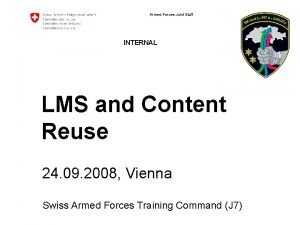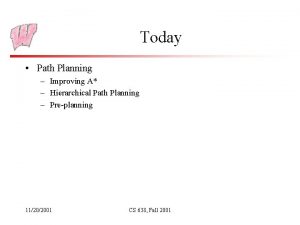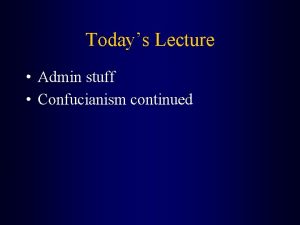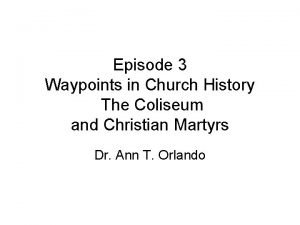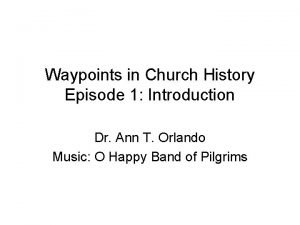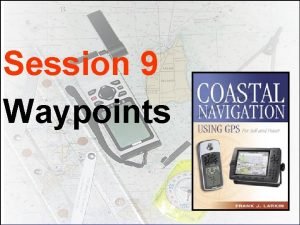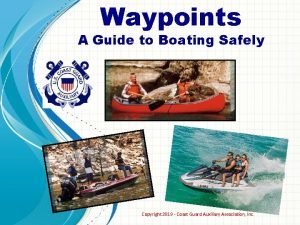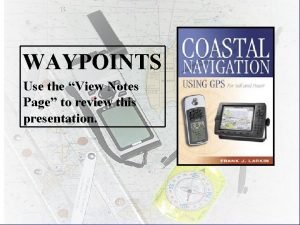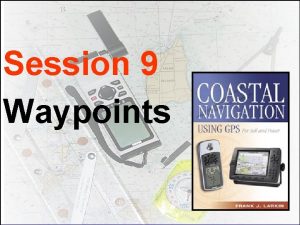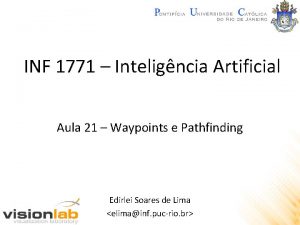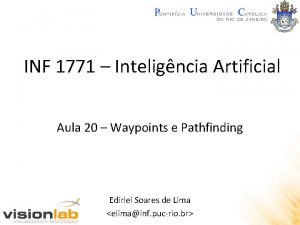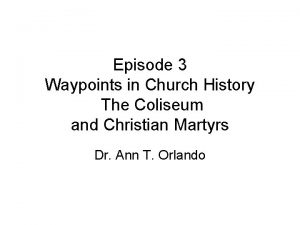Today Admin Path Planning Intro Waypoints A Path
































- Slides: 32

Today • Admin • Path Planning – Intro – Waypoints – A* Path Planning 11/8/2001 CS 638, Fall 2001

Admin Stuff • I’ll be away next week (and unreachable Mon-Fri) – Tuesday: Prof Gleicher on Motion Capture in Games – Thursday: Prof Barford on Network Infrastructure for Games • Project Stage 2: Grading – Grading by demo again, and some code examination – David will do it next week • Project Stage 3: AI free for all – – 11/8/2001 Web page up real soon now Do whatever you want to bring some AI into Target Arena Will be due in three weeks (more time to get more interesting AI) Don’t be too ambitious CS 638, Fall 2001

Path Finding • Problem Statement: Given a start point, A, and a goal point, B, find a path from A to B that is clear – Generally want to minimize a cost: distance, travel time, … • Travel time depends on terrain, for instance – May be complicated by dynamic changes: paths being blocked or removed • Very common problem in games: – In FPS: How does the AI get from room to room? – In RTS: User clicks on units, tells them to go somewhere. How do they get there? How do they avoid each other? – Chase games, sports games, … 11/8/2001 CS 638, Fall 2001

Search or Optimization? • Path planning (also called route-finding) can be phrased as a search problem: – Find a path to the goal B that minimizes Cost(path) – There a wealth of ways to solve search problems, and we will look at some of them • Path planning is also an optimization problem: – Minimize Cost(path) subject to the constraint that path joins A and B • State space is paths joining A and B, kind of messy – There a wealth of ways to solve optimization problems • The difference is mainly one of terminology: different communities (AI vs. Optimization) – But, search is normally on a discrete state space 11/8/2001 CS 638, Fall 2001

Brief Overview of Techniques • Discrete algorithms: BFS, Greedy search, A*, … • Potential fields: – Put a “force field” around obstacles, and follow the “potential valleys” • Pre-computed plans with dynamic re-planning – Plan as search, but pre-compute answer and modify as required • Special algorithms for special cases: – E. g. Given a fixed start point, fast ways to find paths around polygonal obstacles 11/8/2001 CS 638, Fall 2001

Graph-Based Algorithms • Ideally, path planning is point to point (any point in the world to any other, through any unoccupied point) • But, the search space is complex (space of arbitrary curves) • The solution is to discretize the search space – Restrict the start and goal points to a finite set – Restrict the paths to be on lines (or other simple curves) that join points • Form a graph: Nodes are points, edges join nodes that can be reached along a single curve segment – Search for paths on the graph 11/8/2001 CS 638, Fall 2001

Waypoints (and Questions) • The discrete set of points you choose are called waypoints • Where do you put the waypoints? – There are many possibilities • How do you find out if there is a simple path between them? – Depends on what paths you are willing to accept - almost always assume straight lines • The answers to these questions depend very much on the type of game you are developing – The environment: open fields, enclosed rooms, etc… – The style of game: covert hunting, open warfare, friendly romp, … 11/8/2001 CS 638, Fall 2001

Where Would You Put Waypoints? 11/8/2001 CS 638, Fall 2001

Waypoints By Hand • Place waypoints by hand as part of level design – Best control, most time consuming • Many heuristics for good places: – In doorways, because characters have to go through doors and, as we learned in visibility, straight lines joining rooms always go through doors – Along walls, for characters seeking cover – At other discontinuities in the environments (edges of rivers, for example) – At corners, because shortest paths go through corners • The choice of waypoints can make the AI seem smarter 11/8/2001 CS 638, Fall 2001

Waypoints By Grid • Place a grid over the world, and put a waypoint at every gridpoint that is open – Automated method, and maybe even implicit in the environment • Do an edge/world intersection test to decide which waypoints should be joined – Normally only allow moves to immediate (and maybe corner) neighbors • What sorts of environments is this likely to be OK for? • What are its advantages? • What are its problems? 11/8/2001 CS 638, Fall 2001

Grid Example • Note that grid points pay no attention to the geometry • Method can be improved: – Perturb grid to move closer to obstacles – Adjust grid resolution – Use different methods for inside and outside building • Join with waypoints in doorways 11/8/2001 CS 638, Fall 2001

Waypoints From Polygons • Choose waypoints based on the floor polygons in your world • Or, explicitly design polygons to be used for generating waypoints • How do we go from polygons to waypoints? – Hint: there are two obvious options 11/8/2001 CS 638, Fall 2001

Waypoints From Polygons ! Could also add points on walls 11/8/2001 CS 638, Fall 2001

Waypoints From Corners • Place waypoints at every convex corner of the obstacles – Actually, place the point away from the corner according to how wide the moving objects are – Or, compute corners of offset polygons • Connects all the corners that can see each other • Paths through these waypoints will be the shortest • However, some unnatural paths may result – Particularly along corridors - characters will stick to walls 11/8/2001 CS 638, Fall 2001

Waypoints From Corners • NOTE: Not every edge is drawn • Produces very dense graphs 11/8/2001 CS 638, Fall 2001

Getting On and Off • Typically, you do not wish to restrict the character to the waypoints or the graph edges – Not a problem, necessarily, with grid methods • When the character starts, find the closest waypoint and move to that first – Or, find the waypoint most in the direction you think you need to go – Or, try all of the potential starting waypoints and see which gives the shortest path • When the character reaches the closest waypoint to its goal, jump off and go straight to the goal point • Best option: Add a new, temporary waypoint at the precise start and goal point, and join it to nearby waypoints 11/8/2001 CS 638, Fall 2001

Getting On and Off 11/8/2001 CS 638, Fall 2001

Best-First-Search • Start at the start node and search outwards • Maintain two sets of nodes: – Open nodes are those we have reached but don’t know best path – Closed nodes that we know the best path to • Keep the open nodes sorted by cost • Repeat: Expand the “best” open node – If it’s the goal, we’re done – Move the “best” open node to the closed set – Add any nodes reachable from the “best” node to the open set • Unless already there or closed – Update the cost for any nodes reachable from the “best” node • New cost is min(old-cost, cost-through-best) 11/8/2001 CS 638, Fall 2001

Best-First-Search Properties • Precise properties depend on how “best” is defined • But in general: – Will always find the goal if it can be reached – Maintains a frontier of nodes on the open list, surrounding nodes on the closed list – Expands the best node on the frontier, hence expanding the frontier – Eventually, frontier will expand to contain the goal node • To store the best path: – Keep a pointer in each node n to the previous node along the best path to n – Update these as nodes are added to the open set and as nodes are expanded (whenever the cost changes) – To find path to goal, trace pointers back from goal nodes 11/8/2001 CS 638, Fall 2001

Expanding Frontier 11/8/2001 CS 638, Fall 2001

Definitions • g(n): The current known best cost for getting to a node from the start point – Can be computed based on the cost of traversing each edge along the current shortest path to n • h(n): The current estimate for how much more it will cost to get from a node to the goal – A heuristic: The exact value is unknown but this is your best guess – Some algorithms place conditions on this estimate • f(n): The current best estimate for the best path through a node: f(n)=g(n)+h(n) 11/8/2001 CS 638, Fall 2001

Using g(n) Only • Define “best” according to f(n)=g(n), the shortest known path from the start to the node • Equivalent to breadth first search • Is it optimal? – When the goal node is expanded, is it along the shortest path? • Is it efficient? – How many nodes does it explore? Many, few, …? • Behavior is the same as defining a constant heuristic function: h(n)=const – Why? 11/8/2001 CS 638, Fall 2001

Breadth First Search 11/8/2001 CS 638, Fall 2001

Breadth First Search • See Gems for another example: – On a grid with uniform cost per edge, the frontier expands in a circle out from the start point – Makes sense: We’re only using info about distance from the start 11/8/2001 CS 638, Fall 2001

Using h(n) Only (Greedy Search) • Define “best” according to f(n)=h(n), the best guess from the node to the goal state – Behavior depends on choice of heuristic – Straight line distance is a good one • Have to set the cost for a node with no exit to be infinite – If we expand such a node, our guess of the cost was wrong – Do it when you try to expand such a node • Is it optimal? – When the goal node is expanded, is it along the shortest path? • Is it efficient? – How many nodes does it explore? Many, few, …? 11/8/2001 CS 638, Fall 2001

Greedy Search (Straight-Line-Distance Heuristic) 11/8/2001 CS 638, Fall 2001

A* Search • Set f(n)=g(n)+h(n) – Now we are expanding nodes according to best estimated total path cost • Is it optimal? – It depends on h(n) • Is it efficient? – It is the most efficient of any optimal algorithm that uses the same h(n) • A* is the ubiquitous algorithm for path planning in games – Much effort goes into making it fast, and making it produce pretty looking paths – More articles on it than you can poke a stick at 11/8/2001 CS 638, Fall 2001

A* Search (Straight-Line-Distance Heuristic) 11/8/2001 CS 638, Fall 2001

A* Search (Straight-Line-Distance Heuristic) • Note that A* expands fewer nodes than breadth-first, but more than greedy • It’s the price you pay for optimality • See Gems for implementation details. Keys are: – Data structure for a node – Priority queue for sorting open nodes – Underlying graph structure for finding neighbors 11/8/2001 CS 638, Fall 2001

Heuristics • For A* to be optimal, the heuristic must underestimate the true cost – Such a heuristic is admissible • Also, not mentioned in Gems, the f(n) function must monotonically increase along any path out of the start node – True for almost any admissible heuristic, related to triangle inequality – If not true, can fix by making cost through a node max(f(parent) + edge, f(n)) • Combining heuristics: – If you have more than one heuristic, all of which underestimate, but which give different estimates, can combine with: h(n)=max(h 1(n), h 2(n), h 3(n), …) 11/8/2001 CS 638, Fall 2001

Inventing Heuristics • Bigger estimates are always better than smaller ones – They are closer to the “true” value – So straight line distance is better than a small constant • Important case: Motion on a grid – If diagonal steps are not allowed, use Manhattan distance is a bigger estimate than • General strategy: Relax the constraints on the problem – For example: Normal path planning says avoid obstacles – Relax by assuming you can go through obstacles – Result is straight line distance 11/8/2001 CS 638, Fall 2001

Non-Optimal A* • Can use heuristics that are not admissible - A* will still give an answer – But it won’t be optimal: May not explore a node on the optimal path because its estimated cost is too high – Optimal A* will eventually explore any such node before it reaches the goal • Non-admissible heuristics may be much faster – Trade-off computational efficiency for path-efficiency • One way to make non-admissible: Multiply underestimate by a constant factor – See Gems for an example of this 11/8/2001 CS 638, Fall 2001
 For today's meeting
For today's meeting Today's class will be at
Today's class will be at Meeting objective
Meeting objective Fingerprint ridge characteristics worksheet
Fingerprint ridge characteristics worksheet Today's lesson or today lesson
Today's lesson or today lesson Today's lesson or today lesson
Today's lesson or today lesson Unity iot
Unity iot American trans air careers
American trans air careers Athens admin
Athens admin Nextera admin ny
Nextera admin ny Ny.nextera.questar
Ny.nextera.questar Business admin level 3 project presentation examples
Business admin level 3 project presentation examples Quizizz. com/admin
Quizizz. com/admin Rosetta stone sign in page
Rosetta stone sign in page Gmetrix
Gmetrix Ceowin
Ceowin Nctest admin
Nctest admin Https://esanjeevani.in/admin/login
Https://esanjeevani.in/admin/login Srdm ncvvo
Srdm ncvvo Aikido/admin/auth
Aikido/admin/auth Www.lmsvbs.admin.ch
Www.lmsvbs.admin.ch Cern admin e guide
Cern admin e guide Apa yang dimaksud dengan tata buku dalam administrasi
Apa yang dimaksud dengan tata buku dalam administrasi Tugas sarjana kesehatan masyarakat di puskesmas
Tugas sarjana kesehatan masyarakat di puskesmas Rowley standard
Rowley standard Laserfiche training program
Laserfiche training program Surface hub local admin account
Surface hub local admin account Admin grouper
Admin grouper Www.gmetrix
Www.gmetrix Admin
Admin Brocade san switch 명령어
Brocade san switch 명령어 Maryland motorcycle safety program
Maryland motorcycle safety program Benilde sis admin
Benilde sis admin




















